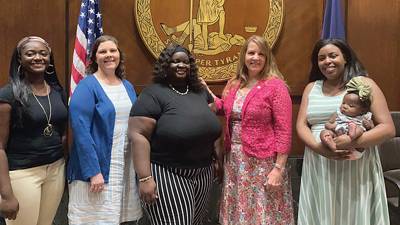Many parents feel the pull on their time and resources to balance work and home. We find and pay for child care, we watch as remote work merges with managing virtual learning, and somehow, we find a way to fit our doctor and dental appointments into our workdays. Two-thirds of households in Virginia have both parents in the workforce, and I’ve worn the working mom label for seven years now. For mothers, the challenges that come with working outside the home are immense.
While women are at a disadvantage in the workforce in general, mothers face even bigger setbacks professionally. Not only is the gender pay gap greater for mothers in the workforce, but there are also cultural-based disadvantages around perceived competency and work ethic and commitment to career-based goals. Sociologists call this worldwide phenomenon the motherhood penalty.
Mothers face a wage gap with long-term consequences.
In a family setting, mothers are likely to do 37 percent more of domestic household work. Mothers are also more likely than fathers to stay at home, take unpaid leave from work, and request additional hours off from work to attend to the needs of our families. The ongoing pandemic has made the choices for working mothers even more difficult. In the past two years, working mothers were more likely than working fathers to consider leaving the workforce altogether. Economists report there are 1.2 million fewer women with school-age children in the workforce today than prior to the pandemic, due to school closures, lack of child care, or reductions in child-care services.
Additionally, many mothers who work in industries where women are overrepresented – such as education, healthcare, and child care – were forced to leave the workforce due to widespread shutdowns. Many of these mothers had to choose between caregiving and their jobs because no telework or remote work options were available to them as essential workers.
Longstanding discriminatory practices that offer lower wages, no protections, and fewer workplace benefits reinforce the motherhood penalty. Non-white single mothers have been hit the hardest.

While some maintain there are many mothers who have a choice in opting out of the workforce, the reality is that many women are providers for their families. In the United States, half of mothers with children under the age of eighteen contribute at least 40 percent of earnings (in other words, breadwinners) in more than 30 million households. According to the U.S. Census, in Virginia there are nearly 965,000 working moms with children under eighteen, and half of those households have a mother who is the breadwinner. Nationally, four out of five Black mothers are the primary wage earners with a majority (56 percent) raising families on their own. For Native American mothers, two out of three (64 percent) are the primary wage earners, with a majority being single parents.
A 2021 analysis by the Century Foundation found that working mothers with children under age five earned less than their childless counterparts. When looking at the intersections of race and ethnicity, the disparity is worse for women of color. Black and Native American mothers earn 20 percent less, Latinas earn 18 percent less, and Asian women earn 13 percent less, while white women earn 10 percent less per child than their childless counterparts. These persistent racial and gender inequities have harmful impacts on children that impact quality of life for families.
Elected officials can do more to address the needs of mothers.
Despite motherhood being revered and celebrated, our policies and pay scales do not treat mothers in the same way.
To fully appreciate the role of women and mothers as leaders in our communities, we need policy changes that are family-friendly and targeted to assist mothers in the workplace. During the last several months, many of Virginia’s representatives in Congress have failed to expand paid family medical leave, extend the child tax credit, or address infant formula shortages.
Elected officials have the power to reduce inequities many mothers face. State lawmakers can show up for parents, women, and families by supporting a state version of a refundable Earned Income Tax Credit (EITC) targeted to low-income taxpayers, which are more likely to be single-parent households. Seventy-two percent of the filers who receive the EITC have children in their households.
Our policymakers can also invest in social infrastructure that supports mothers in the workforce. This includes passing funding plans that keep child-care costs at no more than 7 percent of income and allow mothers to receive assistance while looking for work. Additionally, expanding paid leave options might help mothers maintain their jobs and wages without sacrificing the choice to care for their new babies, sick children, or other family members.
Lastly, we can advocate for fair compensation in the fields that are disproportionately represented by women, such as healthcare, child care, education, and mental health counseling. When we support mothers, we support widespread economic growth and also mothers’ ability to take care of their own families and thrive.
Here’s what you can do to advocate for mother-friendly policies:
Share your story about finding and affording child care to help ensure mothers can access and afford child care and remain in the workforce. To find more information about how you can share your story and get involved, visit vapromisepartnership.com.
Advocate for paid family leave to allow mothers to care for new babies and sick children in the face of child-care disruptions without having to sacrifice income and health insurance. Our partners with the Campaign for a Family-Friendly Economy (familyfriendlyeconomyva.org) advocate for paid family leave.
And if you are a mother thinking of returning to the workforce and want to maximize what you can earn, there are several opportunities to consider:
1. Apply for financial assistance to afford child care through commonhelp.virginia.gov or at your local department of social services. Virginia has made significant improvements to eligibility for assistance by eliminating time limits and child support enforcement requirements and expanding eligibility to higher income families with children under five. Applying for assistance and connecting with an approved child-care vendor can cover a significant portion of child-care costs.
2. For mothers interested in going back into the workforce or changing careers, the G3 Program provides tuition assistance at community colleges across the state for those going into high-demand fields of healthcare, IT, public safety, early education, and skilled trades. Find out how you can apply at virginiag3.com.
My resolve as an advocate for children and families during my career has strengthened over time. For mothers everywhere who work and serve their communities, lead businesses, and care for others, your contributions are invaluable. Now is the time for lawmakers to recognize and reward the contributions of mothers who work outside the home.




